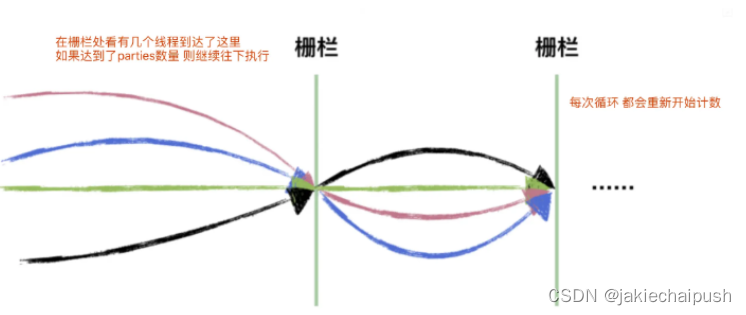深入理解CyclicBarrier
2023-12-14 22:59:04
1. 概念
CyclicBarrier 字面意思回环栅栏(循环屏障),通过它可以实现让一组线程等待至某个状态(屏障点)之后再全部同时执行。叫做回环是因为当所有等待线程都被释放以后,CyclicBarrier可以被重用。CyclicBarrier 作用是让一组线程相互等待,当达到一个共同点时,所有之前等待的线程再继续执行,且 CyclicBarrier 功能可重复使用。

2. CylicBarier使用简单案例
public class Main {
public static void main(String[] args) throws InterruptedException{
CyclicBarrier cyclicBarrier=new CyclicBarrier(3);
for (int i = 0; i < 5; i++) {
new Thread(()->{
try{
System.out.println(Thread.currentThread().getName()+"开始等待其它线程");
//阻塞直到指定方法的数量调用这个方法就会停止阻塞
cyclicBarrier.await();
System.out.println(Thread.currentThread().getName()+"开始执行");
Thread.sleep(5000);
System.out.println(Thread.currentThread().getName()+"执行完毕");
} catch (Exception e) {
e.printStackTrace();
}
}).start();
}
}
}

可以发现只有3个线程继续执行,剩余两个线程被阻塞
3. 源码
- 构造方法
//这个构造方法有两个参数,分别是parties和一个任务,parties代表着屏障拦截的线程数量,每个线程调用 await 方法告诉 CyclicBarrier 我已经到达了屏障,然后当前线程被阻塞。当阻塞的线程达到parties的数量时,就会执行barrieAction这个任务
public CyclicBarrier(int parties, Runnable barrierAction) {
if (parties <= 0) throw new IllegalArgumentException();
this.parties = parties;
//使用两个变量存储parties,这也是parties可以复用的根本原因
this.count = parties;
this.barrierCommand = barrierAction;
}
public CyclicBarrier(int parties) {
this(parties, null);
}
- 重要方法
public int await() throws InterruptedException, BrokenBarrierException {
try {
return dowait(false, 0L);
} catch (TimeoutException toe) {
throw new Error(toe); // cannot happen
}
}
public int await(long timeout, TimeUnit unit)
throws InterruptedException,
BrokenBarrierException,
TimeoutException {
return dowait(true, unit.toNanos(timeout));
}
源码分析要点
1. 一组现场在触发屏障之前互相等待,最后一个线程到达屏障后唤醒逻辑是如何实现的
2. 栅栏循环是如何实现的
3. 条件队列到同步队列的转换实现逻辑
await()方法
public int await() throws InterruptedException, BrokenBarrierException {
try {
return dowait(false, 0L);
} catch (TimeoutException toe) {
throw new Error(toe); // cannot happen
}
}
发现里面实际逻辑调用的是dowait(false, 0L)方法
private int dowait(boolean timed, long nanos)
throws InterruptedException, BrokenBarrierException,
TimeoutException {
//定义了一个ReentrantLock
final ReentrantLock lock = this.lock;
lock.lock();
try {
final Generation g = generation;
if (g.broken)
throw new BrokenBarrierException();
if (Thread.interrupted()) {
breakBarrier();
throw new InterruptedException();
}
//更新count方法
int index = --count;
if (index == 0) { // tripped
boolean ranAction = false;
try {
final Runnable command = barrierCommand;
if (command != null)
command.run();
ranAction = true;
nextGeneration();
return 0;
} finally {
if (!ranAction)
breakBarrier();
}
}
// loop until tripped, broken, interrupted, or timed out
for (;;) {
try {
if (!timed)
//进入条件队列trip进行阻塞
trip.await();
else if (nanos > 0L)
nanos = trip.awaitNanos(nanos);
} catch (InterruptedException ie) {
if (g == generation && ! g.broken) {
breakBarrier();
throw ie;
} else {
Thread.currentThread().interrupt();
}
}
if (g.broken)
throw new BrokenBarrierException();
if (g != generation)
return index;
if (timed && nanos <= 0L) {
breakBarrier();
throw new TimeoutException();
}
}
} finally {
lock.unlock();
}
}
上面方法最核心的就是更新count,然后判断count是否为0,如果为0就开始执行唤醒逻辑(这里先不考虑),如果不为0就会进入trip这个条件队列进行阻塞,下面分析线程是如何进行条件队列阻塞的。
//这是AQS类的一个方法
public final void await() throws InterruptedException {
if (Thread.interrupted())
throw new InterruptedException();
Node node = addConditionWaiter();
int savedState = fullyRelease(node);
int interruptMode = 0;
//判断当亲线程是不是同步队列,不是直接调用park进行阻塞
while (!isOnSyncQueue(node)) {
LockSupport.park(this);
if ((interruptMode = checkInterruptWhileWaiting(node)) != 0)
break;
}
if (acquireQueued(node, savedState) && interruptMode != THROW_IE)
interruptMode = REINTERRUPT;
if (node.nextWaiter != null) // clean up if cancelled
unlinkCancelledWaiters();
if (interruptMode != 0)
reportInterruptAfterWait(interruptMode);
}
往条件等待队列中添加节点就是下面这句代码
Node node = addConditionWaiter();
private Node addConditionWaiter() {
//获得条件队列的最后一个结点
Node t = lastWaiter;
if (t != null && t.waitStatus != Node.CONDITION) {
unlinkCancelledWaiters();
t = lastWaiter;
}
//如果为空就新创建一个节点
Node node = new Node(Thread.currentThread(), Node.CONDITION);
if (t == null)
//如果当前单向队列为空,直接让新创建的节点成为头节点
firstWaiter = node;
else
//否则就放到尾节点的后面
t.nextWaiter = node;
//让尾指针指向当前节点
lastWaiter = node;
//返回当前节点
return node;
}
addConditionWaiter实际是AQS的内部类ConditionObject中实现的
public class ConditionObject implements Condition, java.io.Serializable {
private static final long serialVersionUID = 1173984872572414699L;
//条件队列的第一个节点
private transient Node firstWaiter;
//条件队列的最后一个节点
private transient Node lastWaiter;
public ConditionObject() { }
private Node addConditionWaiter() {
Node t = lastWaiter;
if (t != null && t.waitStatus != Node.CONDITION) {
unlinkCancelledWaiters();
t = lastWaiter;
}
//如果条件队列为空,创建一个新的节点
Node node = new Node(Thread.currentThread(), Node.CONDITION);
if (t == null)
//让新创建的节点成为头节点和尾节点
firstWaiter = node;
else
t.nextWaiter = node;
lastWaiter = node;
return node;
}
private void doSignal(Node first) {
do {
if ( (firstWaiter = first.nextWaiter) == null)
lastWaiter = null;
first.nextWaiter = null;
} while (!transferForSignal(first) &&
(first = firstWaiter) != null);
}
/**
* Removes and transfers all nodes.
* @param first (non-null) the first node on condition queue
*/
private void doSignalAll(Node first) {
lastWaiter = firstWaiter = null;
do {
Node next = first.nextWaiter;
first.nextWaiter = null;
transferForSignal(first);
first = next;
} while (first != null);
}
private void unlinkCancelledWaiters() {
Node t = firstWaiter;
Node trail = null;
while (t != null) {
Node next = t.nextWaiter;
if (t.waitStatus != Node.CONDITION) {
t.nextWaiter = null;
if (trail == null)
firstWaiter = next;
else
trail.nextWaiter = next;
if (next == null)
lastWaiter = trail;
}
else
trail = t;
t = next;
}
}
节点入队后就继续执行 public final void await() throws InterruptedException方法,当调用await()方法,我们需要释放持有的锁,也就是执行下面这句代码:
int savedState = fullyRelease(node);
final int fullyRelease(Node node) {
boolean failed = true;
try {
//获取state标记(独占锁如果state从0-1表示释放锁,从1-0表示占用锁
int savedState = getState();
if (release(savedState)) {
failed = false;
return savedState;
} else {
throw new IllegalMonitorStateException();
}
} finally {
if (failed)
node.waitStatus = Node.CANCELLED;
}
}
public final boolean release(int arg) {
if (tryRelease(arg)) {
Node h = head;
if (h != null && h.waitStatus != 0)
unparkSuccessor(h);
return true;
}
return false;
}
释放锁后回到await()方法,调用下面代码进行实际阻塞
while (!isOnSyncQueue(node)) {
LockSupport.park(this);
if ((interruptMode = checkInterruptWhileWaiting(node)) != 0)
break;
}
上面就队线程阻塞以及入队的原理分析,下面分析count减到0,后是如何执行线程唤醒的,核心代码是:
private int dowait(boolean timed, long nanos)
throws InterruptedException, BrokenBarrierException,
TimeoutException {
if (index == 0) { // tripped
boolean ranAction = false;
try {
final Runnable command = barrierCommand;
if (command != null)
command.run();
ranAction = true;
//开始下一轮屏障
nextGeneration();
return 0;
} finally {
if (!ranAction)
breakBarrier();
}
}
nextGeneration的代码如下:
private void nextGeneration() {
//唤醒条件队列的所有节点
trip.signalAll();
// 恢复count值
count = parties;
generation = new Generation();
}
signalAll()唤醒条件队列中所有的节点
public class ConditionObject implements Condition, java.io.Serializable {
......
private void doSignalAll(Node first) {
//首尾节点置为null
lastWaiter = firstWaiter = null;
do {
//获取首节点的下一个节点
Node next = first.nextWaiter;
//然后将first的nextWaiter指针置为空
first.nextWaiter = null;
//实现头部出队的节点怎么进入同步队列
transferForSignal(first);
//然后开始迭代处理下一个节点
first = next;
} while (first != null);
}
......
}
下面分析头部出队的节点进入同步队列的逻辑
final boolean transferForSignal(Node node) {
//使用CAS操作修改节点的状态
if (!compareAndSetWaitStatus(node, Node.CONDITION, 0))
return false;
//节点入同步队列
Node p = enq(node);
int ws = p.waitStatus;
if (ws > 0 || !compareAndSetWaitStatus(p, ws, Node.SIGNAL))
//p节点的前驱节点置换为-1,这样就可以唤醒node节点,然后调用park进行阻塞
LockSupport.unpark(node.thread);
return true;
}
文章来源:https://blog.csdn.net/qq_43456605/article/details/134868953
本文来自互联网用户投稿,该文观点仅代表作者本人,不代表本站立场。本站仅提供信息存储空间服务,不拥有所有权,不承担相关法律责任。 如若内容造成侵权/违法违规/事实不符,请联系我的编程经验分享网邮箱:veading@qq.com进行投诉反馈,一经查实,立即删除!
本文来自互联网用户投稿,该文观点仅代表作者本人,不代表本站立场。本站仅提供信息存储空间服务,不拥有所有权,不承担相关法律责任。 如若内容造成侵权/违法违规/事实不符,请联系我的编程经验分享网邮箱:veading@qq.com进行投诉反馈,一经查实,立即删除!